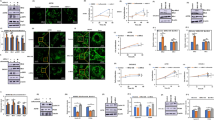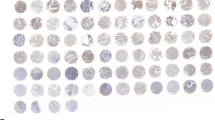Abstract
Dicer is an essential component of the microRNA (miRNA) processing machinery whose low expression is associated with advanced stage and poor clinical outcome in epithelial ovarian cancer. To investigate the functional relevance of Dicer in epithelial ovarian cancer and to identify its downstream effectors, two-dimensional gel electrophoresis combined with mass spectrometry was used for proteomic profiling. Dicer depletion promoted ovarian cancer cell proliferation and migration accompanied by a global upregulation of proteins. Twenty-six proteins, 7 upregulated and 19 downregulated, were identified. The functions of the identified proteins and their interactions were bioinformatically analyzed. Among them, protein disulfide-isomerase A3 (PDIA3) was considered to be a potential target protein of Dicer. PDIA3 repression by siRNA could significantly relieve the proliferation- and migration-promoting effect mediated by Dicer depletion in vitro and in vivo. Moreover, the miRNAs targeting PDIA3 were decreased in cells with Dicer depletion. In summary, low Dicer expression contributes to epithelial ovarian cancer progression by elevating PDIA3 expression.







Similar content being viewed by others
References
Siegel R, Ma J, Zou Z, Jemal A. Cancer statistics, 2014. CA Cancer J Clin. 2014;64:9–29.
Merritt WM, Bar-Eli M, Sood AK. The dicey role of Dicer: implications for RNAi therapy. Cancer Res. 2010;70:2571–4.
Hammond SM. An overview of microRNAs. Adv Drug Deliv Rev. 2015;87:3–14.
Lu J, Getz G, Miska EA, Alvarez-Saavedra E, Lamb J, Peck D, Sweet-Cordero A, Ebert BL, Mak RH, Ferrando AA, Downing JR, Jacks T, Horvitz HR, Golub TR. MicroRNA expression profiles classify human cancers. Nature. 2005;435:834–8.
Wu JF, Shen W, Liu NZ, Zeng GL, Yang M, Zuo GQ, Gan XN, Ren H, Tang KF. Down-regulation of Dicer in hepatocellular carcinoma. Med Oncol. 2011;28:804–9.
Poursadegh Zonouzi AA, Nejatizadeh A, Rahmati-Yamchi M, Fardmanesh H, Shakerizadeh S, Poursadegh Zonouzi A, Nejati-Koshki K, Shekari M. Dysregulated expression of Dicer in invasive ductal breast carcinoma. Med Oncol. 2015;32:203.
Zhang J, Zhang XH, Wang CX, Liu B, Fan XS, Wen JJ, Shi QL, Zhou XJ. Dysregulation of microRNA biosynthesis enzyme Dicer plays an important role in gastric cancer progression. Int J Clin Exp Pathol. 2014;7:1702–7.
Zhao H, Jin X, Su H, Deng X, Fang Y, Shen L, Xie C. Down-regulation of Dicer expression in cervical cancer tissues. Med Oncol. 2014;31:937.
Pampalakis G, Diamandis EP, Katsaros D, Sotiropoulou G. Down-regulation of Dicer expression in ovarian cancer tissues. Clin Biochem. 2010;43:324–7.
Merritt WM, Lin YG, Han LY, Kamat AA, Spannuth WA, Schmandt R, Urbauer D, Pennacchio LA, Cheng JF, Nick AM, Deavers MT, Mourad-Zeidan A, Wang H, Mueller P, Lenburg ME, Gray JW, Mok S, Birrer MJ, Lopez-Berestein G, Coleman RL, Bar-Eli M, Sood AK. Dicer, Drosha, and outcomes in patients with ovarian cancer. N Engl J Med. 2008;359:2641–50.
Faggad A, Budczies J, Tchernitsa O, Darb-Esfahani S, Sehouli J, Muller BM, Wirtz R, Chekerov R, Weichert W, Sinn B, Mucha C, Elwali NE, Schafer R, Dietel M, Denkert C. Prognostic significance of dicer expression in ovarian cancer-link to global microRNA changes and oestrogen receptor expression. J Pathol. 2010;220:382–91.
Kuang Y, Cai J, Li D, Han Q, Cao J, Wang Z. Repression of Dicer is associated with invasive phenotype and chemoresistance in ovarian cancer. Oncol Lett. 2013;5:1149–54.
Kim J, Coffey DM, Creighton CJ, Yu Z, Hawkins SM, Matzuk MM. High-grade serous ovarian cancer arises from fallopian tube in a mouse model. Proc Natl Acad Sci U S A. 2012;109:3921–6.
Hu S, Yu L, Li Z, Shen Y, Wang J, Cai J, Xiao L, Wang Z. Overexpression of EZH2 contributes to acquired cisplatin resistance in ovarian cancer cells in vitro and in vivo. Cancer Biol Ther. 2010;10:788–95.
Zhou J, Cai J, Huang Z, Ding H, Wang J, Jia J, Zhao Y, Huang D, Wang Z. Proteomic identification of target proteins following Drosha knockdown in cervical cancer. Oncol Rep. 2013;30:2229–37.
Zhao S, Wen Z, Liu S, Liu Y, Li X, Ge Y, Li S. MicroRNA-148a inhibits the proliferation and promotes the paclitaxel-induced apoptosis of ovarian cancer cells by targeting PDIA3. Mol Med Rep. 2015;12:3923–9.
Comegna M, Succoio M, Napolitano M, Vitale M, D’Ambrosio C, Scaloni A, Passaro F, Zambrano N, Cimino F, Faraonio R. Identification of mir-494 direct targets involved in senescence of human diploid fibroblasts. FASEB J Off Publ Fed Am Soc Exp Biol. 2014;28:3720–33.
Ma X, Fan Y, Gao Y, Zhang Y, Huang Q, Ai Q, Ni D, Chen W, Zhang P, Song E, Wang B, Shi T, Zheng T, Zhang X. Dicer is down-regulated in clear cell renal cell carcinoma and in vitro dicer knockdown enhances malignant phenotype transformation. Urol Oncol. 2014;32:46 e49–17.
Zeng S, Yang J, Zhao J, Liu Q, Rong M, Guo Z, Gao W. Silencing Dicer expression enhances cellular proliferative and invasive capacities in human tongue squamous cell carcinoma. Oncol Rep. 2014;31:867–73.
Muller PA, Trinidad AG, Caswell PT, Norman JC, Vousden KH. Mutant p53 regulates Dicer through p63-dependent and -independent mechanisms to promote an invasive phenotype. J Biol Chem. 2014;289:122–32.
Iliou MS, da Silva-Diz V, Carmona FJ, Ramalho-Carvalho J, Heyn H, Villanueva A, Munoz P, Esteller M. Impaired dicer1 function promotes stemness and metastasis in colon cancer. Oncogene. 2014;33:4003–15.
Chiosea S, Jelezcova E, Chandran U, Acquafondata M, McHale T, Sobol RW, Dhir R. Up-regulation of Dicer, a component of the microRNA machinery, in prostate adenocarcinoma. Am J Pathol. 2006;169:1812–20.
Muralidhar B, Goldstein LD, Ng G, Winder DM, Palmer RD, Gooding EL, Barbosa-Morais NL, Mukherjee G, Thorne NP, Roberts I, Pett MR, Coleman N. Global microRNA profiles in cervical squamous cell carcinoma depend on Drosha expression levels. J Pathol. 2007;212:368–77.
Sugito N, Ishiguro H, Kuwabara Y, Kimura M, Mitsui A, Kurehara H, Ando T, Mori R, Takashima N, Ogawa R, Fujii Y. RNASEN regulates cell proliferation and affects survival in esophageal cancer patients. Clin Cancer Res Off J Am Assoc Cancer Res. 2006;12:7322–8.
Zhang B, Chen H, Zhang L, Dakhova O, Zhang Y, Lewis MT, Creighton CJ, Ittmann MM, Xin L. A dosage-dependent pleiotropic role of dicer in prostate cancer growth and metastasis. Oncogene. 2014;33:3099–108.
Kurzynska-Kokorniak A, Koralewska N, Pokornowska M, Urbanowicz A, Tworak A, Mickiewicz A, Figlerowicz M. The many faces of Dicer: the complexity of the mechanisms regulating dicer gene expression and enzyme activities. Nucleic Acids Res. 2015;43:4365–80.
Coppari S, Altieri F, Ferraro A, Chichiarelli S, Eufemi M, Turano C. Nuclear localization and DNA interaction of protein disulfide isomerase ERp57 in mammalian cells. J Cell Biochem. 2002;85:325–33.
Turano C, Gaucci E, Grillo C, Chichiarelli S. ERp57/GRP58: a protein with multiple functions. Cell Mol Biol Lett. 2011;16:539–63.
Chichiarelli S, Ferraro A, Altieri F, Eufemi M, Coppari S, Grillo C, Arcangeli V, Turano C. The stress protein ERp57/GRP58 binds specific DNA sequences in HeLa cells. J Cell Physiol. 2007;210:343–51.
Eufemi M, Coppari S, Altieri F, Grillo C, Ferraro A, Turano C. ERp57 is present in STAT3-DNA complexes. Biochem Biophys Res Commun. 2004;323:1306–12.
Hirano N, Shibasaki F, Sakai R, Tanaka T, Nishida J, Yazaki Y, Takenawa T, Hirai H. Molecular cloning of the human glucose-regulated protein ERp57/GRP58, a thiol-dependent reductase. Identification of its secretory form and inducible expression by the oncogenic transformation. Eur j Biochem FEBS. 1995;234:336–42.
Celli CM, Jaiswal AK. Role of GRP58 in mitomycin c-induced DNA cross-linking. Cancer Res. 2003;63:6016–25.
Santana-Codina N, Carretero R, Sanz-Pamplona R, Cabrera T, Guney E, Oliva B, Clezardin P, Olarte OE, Loza-Alvarez P, Mendez-Lucas A, Perales JC, Sierra A. A transcriptome-proteome integrated network identifies endoplasmic reticulum thiol oxidoreductase (ERp57) as a hub that mediates bone metastasis. Mol Cell Proteomics MCP. 2013;12:2111–25.
Liao CJ, Wu TI, Huang YH, Chang TC, Wang CS, Tsai MM, Lai CH, Liang Y, Jung SM, Lin KH. Glucose-regulated protein 58 modulates cell invasiveness and serves as a prognostic marker for cervical cancer. Cancer Sci. 2011;102:2255–63.
Cicchillitti L, Di Michele M, Urbani A, Ferlini C, Donat MB, Scambia G, Rotilio D. Comparative proteomic analysis of paclitaxel sensitive A2780 epithelial ovarian cancer cell line and its resistant counterpart A2780tc1 by 2D-DIGE: the role of ERp57. J Proteome Res. 2009;8:1902–12.
Chichiarelli S, Gaucci E, Ferraro A, Grillo C, Altieri F, Cocchiola R, Arcangeli V, Turano C, Eufemi M. Role of ERp57 in the signaling and transcriptional activity of STAT3 in a melanoma cell line. Arch Biochem Biophys. 2010;494:178–83.
Liao CJ, Wu TI, Huang YH, Chang TC, Lai CH, Jung SM, Hsueh C, Lin KH. Glucose-regulated protein 58 modulates beta-catenin protein stability in a cervical adenocarcinoma cell line. BMC Cancer. 2014;14:555.
Sansone P, Bromberg J. Targeting the interleukin-6/Jak/stat pathway in human malignancies. J Clin Oncol Off J Am Soc Clin Oncol. 2012;30:1005–14.
Anastas JN, Moon RT. Wnt signalling pathways as therapeutic targets in cancer. Nat Rev Cancer. 2013;13:11–26.
Tan FH, Putoczki TL, Stylli SS, Luwor RB. The role of STAT3 signaling in mediating tumor resistance to cancer therapy. Curr Drug Targets. 2014;15:1341–53.
Author contributions
Jing Cai and Zehua Wang conceived and designed the research. Ying Zhu and Liqiong Cai performed the experiments and analyzed the data. Na Chen, Xiaoqing Yi, Jing Guo, and Yong Zhao provided administrative and technical support. Ying Zhu wrote the manuscript. All authors read and approved the final manuscript.
Author information
Authors and Affiliations
Corresponding authors
Ethics declarations
Funding
This work was supported by the National Natural Science Foundation of China (Nos. 81502248 and 81572572).
Conflicts of interest
None
Ethical approval
All procedures performed in studies involving animals were in accordance with the ethical standards of the Institutional Animal Care and Use Committee of the Tongji Medical College, Huazhong University of Science and Technology.
Additional information
Ying Zhu and Liqiong Cai contributed equally to this work.
Rights and permissions
About this article
Cite this article
Zhu, Y., Cai, L., Guo, J. et al. Depletion of Dicer promotes epithelial ovarian cancer progression by elevating PDIA3 expression. Tumor Biol. 37, 14009–14023 (2016). https://doi.org/10.1007/s13277-016-5218-4
Received:
Accepted:
Published:
Issue Date:
DOI: https://doi.org/10.1007/s13277-016-5218-4




